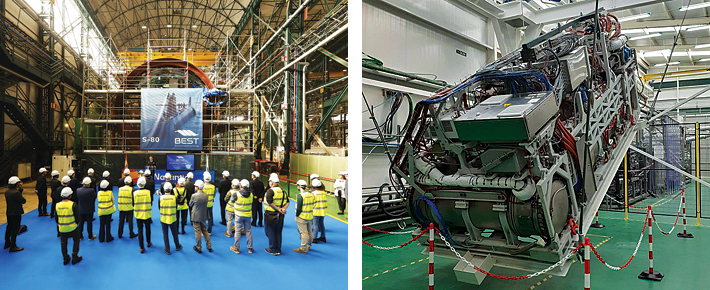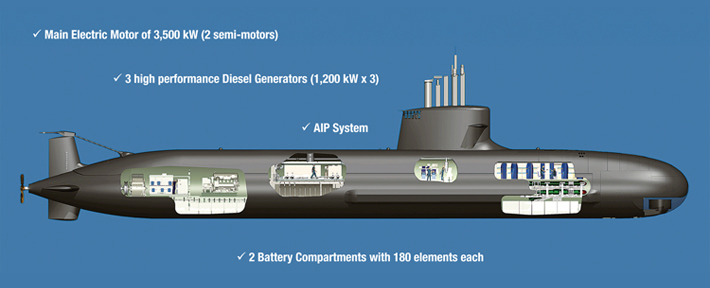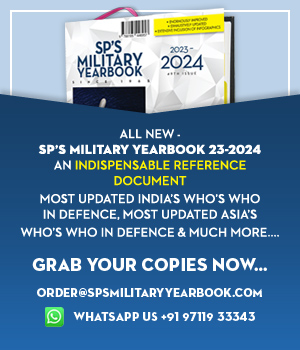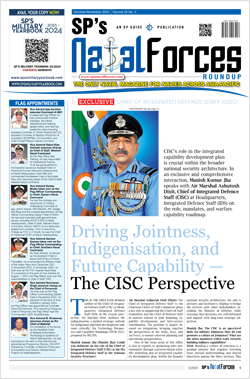INDIAN ARMED FORCES CHIEFS ON OUR RELENTLESS AND FOCUSED PUBLISHING EFFORTS

The insightful articles, inspiring narrations and analytical perspectives presented by the Editorial Team, establish an alluring connect with the reader. My compliments and best wishes to SP Guide Publications.

"Over the past 60 years, the growth of SP Guide Publications has mirrored the rising stature of Indian Navy. Its well-researched and informative magazines on Defence and Aerospace sector have served to shape an educated opinion of our military personnel, policy makers and the public alike. I wish SP's Publication team continued success, fair winds and following seas in all future endeavour!"

Since, its inception in 1964, SP Guide Publications has consistently demonstrated commitment to high-quality journalism in the aerospace and defence sectors, earning a well-deserved reputation as Asia's largest media house in this domain. I wish SP Guide Publications continued success in its pursuit of excellence.
SUBMARINES / TECHNOLOGY
Navantia’s Naval Prowess
Powering the Future of Global Maritime Defence

From cutting-edge submarine technology and Air-Independent Propulsion (AIP) systems to strong partnerships with the Spanish Navy and expanding global deliveries, Navantia is redefining shipbuilding for 21st-century maritime security.
Navantia, Spain’s leading naval shipbuilder, has established itself as a cornerstone of maritime defence innovation in Europe and beyond. With a heritage rooted in centuries of naval construction, the company today is renowned for its advanced submarines, surface vessels, and integrated combat systems. Working closely with the Spanish Navy, while expanding its international footprint—from Australia to India—Navantia exemplifies the blend of tradition, technological sophistication, and strategic agility. As global navies modernise their fleets, Navantia’s role has become increasingly critical in the evolving landscape of maritime power.
Historical Legacy and Technological USPs
Navantia was formed in 2005 following the restructuring of Spain’s state-owned shipbuilding industry, but its shipyards in Cartagena, Ferrol, and San Fernando trace their roots back several hundred years. It operates as a subsidiary of SEPI (Sociedad Estatal de Participaciones Industriales), reflecting its strategic importance to Spain’s industrial and defence policy.
Navantia’s mission is clear: to be a global leader in naval construction, system integration, and life-cycle support. Its business verticals span the full spectrum of maritime defence needs—surface combatants, submarines, auxiliary vessels, and advanced digital solutions for ship management.
One of Navantia’s standout technological capabilities lies in its expertise in integrated combat systems. The company’s CATIZ Combat System and SCOMBA, a scalable command-and-control architecture developed with the Spanish Navy, provide interoperability and real-time tactical awareness—key differentiators in modern maritime warfare.
Another major USP is its development of Air-Independent Propulsion (AIP) for submarines. The AIP system, based on fuel-cell technology, significantly extends submerged endurance, making submarines quieter and more difficult to detect. This technology features prominently in the S-80 Plus class submarine, making Navantia one of only a few shipbuilders globally to design and build submarines with indigenous AIP technology.
S-80 Plus: The Flagship Submarine Programme
Navantia’s flagship submarine initiative, the S-80 Plus, is a critical leap in autonomous underwater operations. Designed entirely in Spain, the S-80 series is built at Navantia’s Cartagena shipyard and represents the most ambitious naval programme undertaken in the country.
Navantia specializes in the construction of all types of surface military ships and submarines, as well as in engine manufacturing incorporating advanced technologies
These submarines feature advanced combat systems, an extended range with the AIP module, reduced acoustic signatures, and significant payload capacity. The first in class, Isaac Peral (S-81), underwent sea trials and is scheduled to be commissioned by the Spanish Navy in 2025, followed by Narciso Monturiol (S-82) and two others.
Navantia’s strategic alignment with the Spanish Navy continues to be a cornerstone of its business. The S-80 Plus submarines, F-110 frigates (under construction), and auxiliary ships like the BAC Cantabria highlight a strong home-market foundation. This long-standing collaboration allows Navantia to validate, test, and evolve technologies before deploying them in export markets.

The F-110 frigates, in particular, are set to integrate next-generation radar systems, cyber-defence infrastructure, and artificial intelligence for autonomous operations— demonstrating Navantia’s vision for multidomain naval warfare.
Global Footprint: Exports and Collaborations
Navantia’s export capabilities are significant. The company has delivered advanced platforms to a wide array of navies:
- Australia: Navantia collaborated on the Hobart-class Air Warfare Destroyers and Canberra-class Landing Helicopter Docks, delivering both platforms and design expertise. The Royal Australian Navy is also sourcing auxiliary ships from Navantia under the SEA 1654 programme.
- Saudi Arabia: Navantia partnered with Saudi Arabian Military Industries (SAMI) to build Avante 2200 corvettes for the Royal Saudi Naval Forces. The first ship, Al Jubail, was delivered in 2022, and the programme includes extensive technology transfer.
- Turkey: The design of Turkey’s flagship amphibious assault ship, TCG Anadolu, is based on Navantia’s Juan Carlos I, showing the company’s role in transferring complex warship design and know-how.
- Norway and India: Navantia has participated in technology bids and partnerships in these regions, positioning itself as a capable design collaborator in submarine and surface vessel procurement.
Navantia in India: A Growing Interest
While not yet a major supplier, Navantia has shown growing interest in India’s expanding defence market. Most notably, it was among the contenders in the Indian Navy’s P-75(I) submarine programme, offering the S-80 Plus design with AIP capability. Navantia had tied up with Larsen & Toubro (L&T) to bid for this project. Navantia’s willingness to engage in technology transfer and co-production aligns with India’s ‘Make in India’ and strategic partnership models.
Navantia has also explored collaboration with Indian shipyards for surface combatant programmes, potentially positioning itself as a long-term partner for naval design and system integration.
Shaping the Naval Future
Navantia is also investing heavily in Industry 4.0 technologies. Through its ‘Navantia 4.0’ programme, the company is implementing digital twins, automated welding, augmented reality, and smart logistics in shipyards to improve precision and reduce build times. This effort supports not just product delivery but also after-sales lifecycle support and fleet readiness.
Its commitment to sustainability is evident in green propulsion research and modular designs that allow for future upgrades, hybrid systems, and emission compliance—an increasingly important metric for international naval operators.
Navantia has successfully transitioned from a state-owned shipbuilder focused on its domestic navy to a world-class naval enterprise. Through AIP submarines, nextgen combat systems, robust partnerships, and forward-looking digitalisation, the company now stands at the cutting edge of naval capability. As strategic tensions shift from the Atlantic to Indo-Pacific, Navantia’s growing global presence and technological agility suggest a larger role in shaping maritime power in the decades to come.





